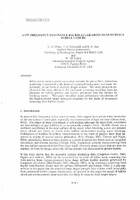| dc.contributor.author | Crum, L. A. | |
| dc.contributor.author | Schindall, J. A. | |
| dc.contributor.author | Roy, R. A. | |
| dc.contributor.author | Carey, William M. | |
| dc.date.accessioned | 2018-10-11T14:05:38Z | |
| dc.date.available | 2018-10-11T14:05:38Z | |
| dc.date.issued | 1993/08 | |
| dc.identifier | 795 | |
| dc.identifier.govdoc | CP-42/1 | |
| dc.identifier.uri | http://hdl.handle.net/20.500.12489/129 | |
| dc.description.abstract | When active sonar systems are used to insonate the sea surface, anomalous scattering is observed in the form of enhanced backscatter, and more importantly, in the form of discrete, bright echoes. The most plausible explanation for these effects is the increased scattering resulting from the presence of bubble plumes and clouds, produced near the surface by breaking waves. This paper describes some preliminary calculations of the back scattered target strengths expected on the basis of resonance scattering from bubble clouds | |
| dc.format | 16 p. : ill., 14 fig. ; digital, PDF file | |
| dc.language | English | |
| dc.publisher | NATO. SACLANTCEN | |
| dc.source | In: Low frequency active sonar (SACLANTCEN Conference Proceedings CP-42), vol. 1, 1993, pp. B/9-1 - B/9-16. | |
| dc.subject | Low Frequency Active Sonar (LFAS) | |
| dc.subject | Bubbles | |
| dc.subject | Acoustic scattering - Seafloor and sea surface | |
| dc.subject | Target strength | |
| dc.title | Low frequency resonance backscatter from near-surface bubble clouds | |
| dc.type | Papers and Articles | |
| dc.type | Conference Proceedings (CP) | |
